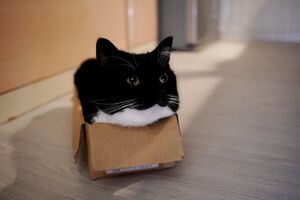Cats as a Part of Garfcord Culture

Pets, and cats in particular, have been historically part of LGBT culture[1]. In the United States, LGBT adults are more likely to own a pet of some kind than cishet adults, amplified in childless adults[1][2]. Surveys conducted have shown that Garfcord users are almost 15% more likely to own pets than the average cishet adult, and over 10% more likely to own pets than the average LGBT adult[3]. Recently, academics have shone more of a spotlight on "the intersections of human and animal lives in the context of LGBT communities".
History of Pets and Cats as a Part of LGBT Culture
Pets have originally been used as a method of support among childless homosexual men and women, especially among older LGBT people, where pets have been observed to have a significant positive impact on mental health[4][5]. Studies have shown that LGBT pet owners are more likely to view pets as a "companion" rather than an inferior[6].
Cats, in particular, have been a long-standing symbol of the LGBT community due to their historical associations with the "oddballs" of society, and their tendency to get along well with people who "stand out". When cats were first domesticated thousands of years ago, they were seen as mysterious and mystical, hence their depictions as gods and higher beings in Ancient Egyptian culture[7]. Starting in the 17th century, the Witch Trials saw lonely cat owners accused of witchcraft, stating that cats were the "companions of witches" and a "symbol of Pagan culture"[8]. Furthermore, witches were believed to have a deep personal bond with their feline companions, even leading to the belief that witches grew a third nipple in order to feed their cats[9].
Historians, LGBT people, and feminists alike have drawn parallels between witchcraft and LGBT culture, with the belief that witches were the "outcasts" of society mirroring the treatment of the LGBT community today. Some groups have even reclaimed the "witchcraft" aesthetic, with subreddits such as r/witchesvspatriarchy becoming increasingly popular[10]. In media, cats are sometimes used as a "lazy shorthand" for independent feminine-presenting people, ranging from "crazy cat ladies" to clichés about effeminate gay men and lonely lesbian women[11].
The significant historical association of cats with outcasts and oddballs, combined with the tendency of LGBT people to gravitate towards furry friends, has likely led to cat people being more likely to be queer, and the popular depictions of cats and other animals in media today.
Usage of Cats in Garfcord
History
Since Garfcord originated as a discord server for r/196 users to collaborate on r/place[12], it adopted some of 196's imagery, such as Floppa and Sogga. This caused spin-off emotes featuring the two cats, alongside other animal imagery such as Spronkus.
The creation of Garfcord led to many users becoming active participants in the race to become a moderator. Eventually, a few select users were chosen, most of whom - by coincidence or otherwise - had cat-based profiles or online personas. Prominent examples include Creepercattum, Joxi / Neil, and Luna, the server owner. Users believe that the prominence of cat-based personas in the server is likely due to the tendency for "cat people" to be more introverted, and therefore spend more time on Discord[13][14].
Usage of Cats in GIFs and Memes
Floppa and Sogga
Floppa and Sogga, a caracal and a serval respectively, are not technically cats, however do stem from the Felinae sub-family[15][16][17]. These two funny-looking felines have become iconic in the server, stemming emotes such as soggy and floppastare.
Professor Jones, aka the "Canny Cat"
Professor Jones became an internet icon after his owner posted a picture on r/cats with the caption "When you accidentally switch to the front facing camera". He is now used in many GIFs and memes throughout the server, such as in gifs where certain objects are replaced with the cat's face in greyscale.
Big Boobs
Uni, known colloquially as Big Boobs due to a meme with a photo of the cat and the caption, "This cat's name is Big Boobs, look him up on your school computer", has become an iconic cat due to his resemblance to the :3 emoticon.
Usage of Cats as Tone Indicators
Creating emotes featuring iconic cats has inadvertently created a tool to match tone indicators. For example, the soggy emote is commonly used to convey a sense of disappointment, due to the serval's human-like features. Other prominent examples include uncanny, a desaturated image of Professor Jones, commonly used to display an impending sense of doom or an uncanny feeling. Reaction emotes also allow users to convey how they feel about messages, such as expressing sadness or shock. Most of these emotes are mainly used in a humorous capacity, however they do provide an important tool for online communication, similarly to emoji[18].
- ↑ 1.0 1.1 https://oro.open.ac.uk/62289/3/62289.pdf
- ↑ https://www.advocate.com/news/2007/12/18/poll-gays-more-likely-own-pets
- ↑ https://drive.google.com/file/d/1mY3zsqX7unfR5e9YxAt29vtu46YVnwFT/view?usp=sharing
- ↑ https://www.ncbi.nlm.nih.gov/pmc/articles/PMC6888196
- ↑ https://www.ncbi.nlm.nih.gov/pmc/articles/PMC6027597
- ↑ https://www.palgrave.com/gp/campaigns/lgbtiq-equality/riggs-on-lgbt-people-and-their-relationships-with-animals
- ↑ Malek, J. (1997). The Cat in Ancient Egypt (Revised ed.). Pennsylvania: University of Pennsylvania Press. ISBN 9780812216325.
- ↑ Cats, Symbolism and the 16th Century Witch Craze – Cheshire & Wain (cheshireandwain.com)
- ↑ The Devil’s Mark | (lawexplores.com)
- ↑ Witches vs Patriarchy (reddit.com)
- ↑ https://books.google.com/books?id=QJ0MEAAAQBAJ&pg=PA10
- ↑ (Self-evident, but you can check here for confirmation)https://discord.com/channels/959267794409652274/1059217965360357406/1117585741346775120
- ↑ https://www.psychologytoday.com/blog/unique-everybody-else/201304/cat-people-are-more-distinctive-dog-people
- ↑ i'm sorry please dont come after me this is in good faith and its science-based and stuff i promisj
- ↑ https://archive.org/details/mobot31753000798865/page/42
- ↑ Caracal - Wikipedia
- ↑ https://archive.org/stream/SaYugthiereAbbiIIISchr#page/406/mode/2up
- ↑ How have emojis transformed the ways we communicate? | by hamza | Bootcamp (uxdesign.cc)